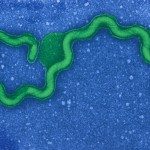Link to Pubmed [PMID] – 40698983
Link to DOI – 10.1128/mbio.00645-25
mBio 2025 Aug; 16(8): e0064525
Dioxygen (O2) is vital for aerobic life, but its utilization leads to the inevitable production of superoxide, a toxic oxidant. The prevailing theory of oxygen toxicity postulates that superoxide-scavenging enzymes (SOSEs), such as superoxide dismutases (SODs), are crucial for most aerobes and play a key role in the virulence of pathogens. However, our knowledge of superoxide adaptation primarily stems from the study of SOSE-encoding bacteria. Here, we investigated the evolution of a naturally SOSE-deficient pathogen (Leptospira spp.) and its alternative mechanisms to combat superoxide stress. We demonstrated that SOD was ancestral in the genus Leptospira but lost by pathogenic species, and heterologous expression of a SOD in this pathogen did not improve superoxide tolerance. In L. interrogans, inheritable increased expression of a genetic locus, including a MFS transporter, mediated a long-lasting adaptation to superoxide, independently of any permanent genetic modification. Using a multi-omics approach, we identified a leuA2-encoded isopropylmalate synthase, the enzyme catalyzing the first step of leucine biosynthesis, as the most upregulated factor by superoxide. Interestingly, LeuA2 lacks the canonical domain for feedback inhibition by leucine and is the only upregulated factor of leucine biosynthesis, suggesting a moonlighting activity for LeuA2 in the adaptation to superoxide. Moreover, the cysteine biosynthesis pathway was significantly upregulated in response to superoxide, and we demonstrated the importance of sulfur metabolism in adaptation to superoxide. This study revisits our conventional understanding of the oxygen toxicity theory and proposes a new model of superoxide adaptation through redox-based metabolic rewiring in SOSE-deficient aerobic bacteria.IMPORTANCESuperoxide is a toxic reactive oxygen species produced as an inevitable byproduct during oxygen respiration. It is therefore assumed that aerobic bacteria require superoxide scavenging enzymes (SOSEs), such as superoxide dismutases. Recent studies estimate that around 10% of all living organisms lack SOSEs. However, we ignore how these organisms survive superoxide stress when confronted with oxygen. Here, using Leptospira interrogans, a naturally SOSE-deficient aerobic pathogen, we address the evolutionary path and defense mechanisms leading to the adaptation to superoxide in the absence of any SOSE. We demonstrate that a SOD was ancestral in this genus but was lost with the emergence of pathogenic species. In addition, we show that pathogenic Leptospira induce metabolic pathways to fight superoxide, such as cysteine biosynthesis and isopropylmalate synthase. Thus, our study reveals that redox-based metabolic reprogramming may compensate for the loss of SOSEs in pathogenic bacteria.




